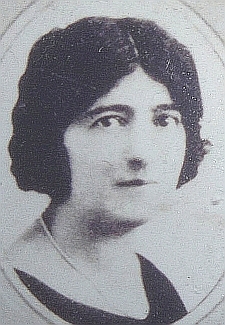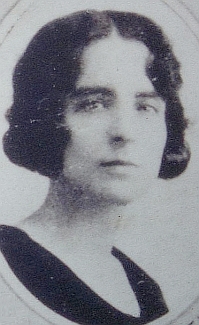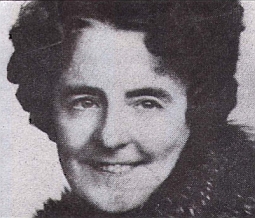|
Affectionately known as "the girls",
Edith Emma and Minnie Laurel Pardey were duo pianists. Both girls received an effective
musical grounding at the convent at Katoomba in New South Wales,
Australia. They also studied in Sydney for examinations of the
Associated Board of the Royal Academy of Music and the Royal College
of Music. Each of them gained medals. Their father, Edmund, was a
coach builder and their mother Minnie, nee Cooper, was a seamstress.
The family ran a guest-house for people holidaying in Katoomba at the
Blue Mountains. The Pardey guest-house was very popular because the
Saturday night dancing was accompanied by the two Pardey girls playing
as duets all the popular hits of the day. Edith was also the organist
at St Hilda's Church, while Laurel was the dinner-music pianist at the
prestigious Hotel Carrington.
It was at the Carrington and
subsequently at the Pardey guest-house that George Horton heard Laurel
play. He was so impressed that he asked her to come to the City Road
premises of E.F.Wilks to play the "recording" pianola which he had
invented. This event occurred sometime in 1917 - the date is vague -
and the tune recorded is now subject to some dispute. Laurel always
maintained that it was a popular song of the day, "Yarrawonga", which,
however, when roll manufacture began, appeared as the
thirteenth roll released on the then "Duo" label. George Horton in his
reminiscences claimed that had he taken a shot-gun and fired it
through the paper he would have achieved the same effect as his
recording machine, for as it was, it worked too slowly to record the
correct timing of this dance tune. Nevertheless the results of this
first recording session were sufficiently attractive to encourage Eric
Howes of Howes & Howes Ltd - Gentlemen's Outfitters - of Pitt Street
Sydney, to put up the capital for the establishment of G.H.Horton & Co
Ltd and to send George Horton to America to buy the necessary
machinery to manufacture piano rolls at E.F.Wilks' City Road factory.
Edith and Laurel Pardey, together with
the Ludermanns, became George Horton's first employees in his piano
roll manufacturing venture, which eventually became known as the
Mastertouch Piano Roll Co.
  
Edith (left) and Laurel Pardey - from an
early Mastertouch advertising poster.
Unlike the popular recording artists of
today, Edith and Laurel were "nine-to-fivers", that is they commenced
work at nine o'clock on Monday morning and finished the five day week
at five o'clock on Friday evening. Initially they were kept very busy
"churning out the pops" to build up a supply of masters which could
become the basis of a catalogue in continuity. Laurel was interested
in foxtrots; Edith specialized in waltzes. Eventually, as more and
more "named" artists were called in to record, Edith, especially, was
expected to edit their work - that is, these artists simply played
their work on the keyboard and went home, Edith did the rest. This
apprenticeship was to serve her in good stead later in her life, when
the Horton recording machine had broken down and she was expected to
sit down and simply graph out the music roll arrangement on blank
paper, which she subsequently turned into a master roll by cutting it
out, hole by hole, on the hand cutter.
On 5 November 1924, Edith married Frank Baker Murn
(1895-1957), the
Director of Post and Telegraph in New South Wales. Frank was an
extremely sentimental man and outside of his official work he gave his
time to writing poetry. This came as a great boon to the roll
industry, because, when George Horton gave the edict that piano rolls
wherever possible should have printed words, Frank Baker Murn obliged
by writing lyrics where there were none! Edith continued on as
recording artist until her son, Pardey Murn, was born in 1933. Laurel then
continued on through the difficult days of the Second World War. To
maintain the illusion that a number of artists were recording, the
names Edith & Laurel Pardey, Laurel Pardey and E. Murn were alternated
on the new releases. It's also possible that in the 1928-1935 period,
Edith and Laurel adopted the peudonyms Cecil de Vrey and Fred Jacobs
respectively, as the styles are similar and no biographical
information can be found on anyone existing with these names in the
area.

Laurel, who drove a flashy Chrysler 770
coupé, married the 28 year old John O'Sullivan on 16 August 1941. No
doubt to conceal the considerable age difference between them, she
gave her age as 35! In the later years of World War II, so onerous was
the task of recording and keeping to production dead-lines, while
worrying about her husband, who was away at the front, Laurel had a
nervous breakdown and retired (this may have occurred in 1948). So
that roll manufacture could be sustained through this critical time,
Edith returned as recording artist and began cutting the masters on
the hand-cutter - from 1950 she was paid an allowance dependent on the
length of the roll. She kept on recording until her death from cancer
in 1961, although her task became exceedingly difficult as more and
more of the ancillary machinery fell into disrepair.
A later photograph of Laurel Pardey
Current owner of Mastertouch, Barclay
Wright, has memories of Edith, when she was recording for The
Mastertouch Piano Roll Company (1961), sitting at a little wicker
table, graphing out the master-roll by hand. The most astounding thing
about this was that the music-rule she used as a scale had been used
so often that all the engraved coding on it had worn off and she was
virtually doing it from memory! Key-changes, introductions and endings
were traced from old rolls just as you would trace through a stencil.
So onerous was this activity that no repeat passages would be
"recorded" and the roll was joined much as editors now join films, by
utilising alphabetical phrasing - that is; A-B, C-D, A-B, E-F etc
until the complete arrangement had been "recorded". One other
interesting short-cut Edith used in her hand-cutting was to record the
melody in the right-hand, or treble, as a double-octave chord, through
which she would draw a blue line. As a musical variation, on one
passage, the master-worker, when joining Edith's hand-cut master for a
final, was required to leave all the holes above the blue line open,
"masking off" those below with little pieces of paper as the Edith's
master passed over the "reading" bar on the master machine. On another
passage the master-worker might be required to leave those below the
line open, and to block off those above. It was a little like the
children's game "Fly Away, Peter Fly Away, Paul" with embarrassing
results if the master-worker became confused so that on the final roll
the melody jumped up then down an octave in the middle of a phrase.
Over the years Edith and Laurel built
up the huge repertoire of waltzes and foxtrots which to this day
remain the "evergreens" for piano-roll playing enthusiasts, who
sentimentally yearn for the good old days of the family sing-song
around the pianola. "The Girls" in their four-handed arrangements
became masters at converting marches and even sentimental old ballads
such as "Moonlight and Roses" into their now familiar "pianola-style"
- a style which produced the sound now synonymous for most Australians
today with the very word pianola!
This information was
sourced from the Mastertouch Piano Roll Company.
|





